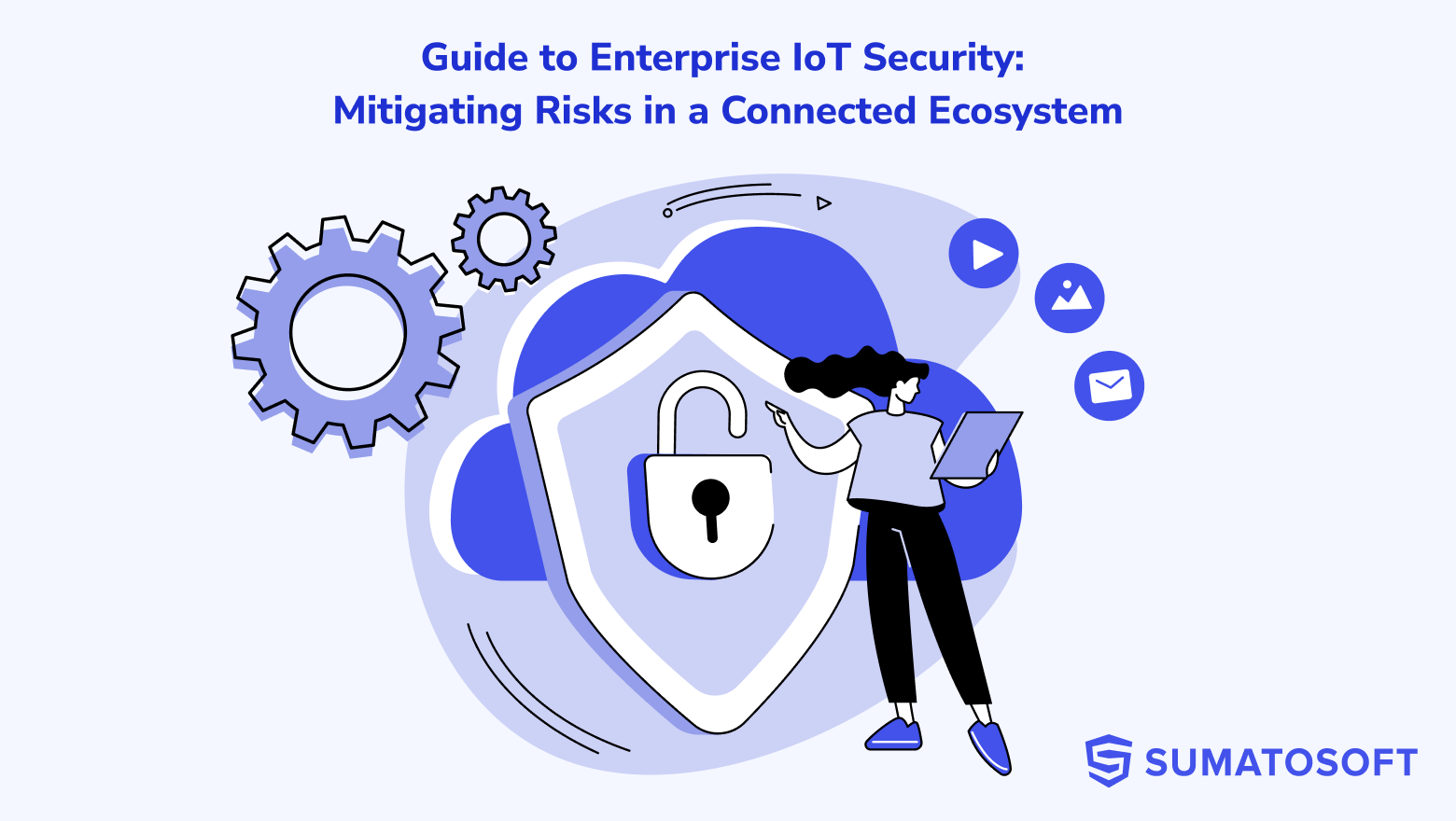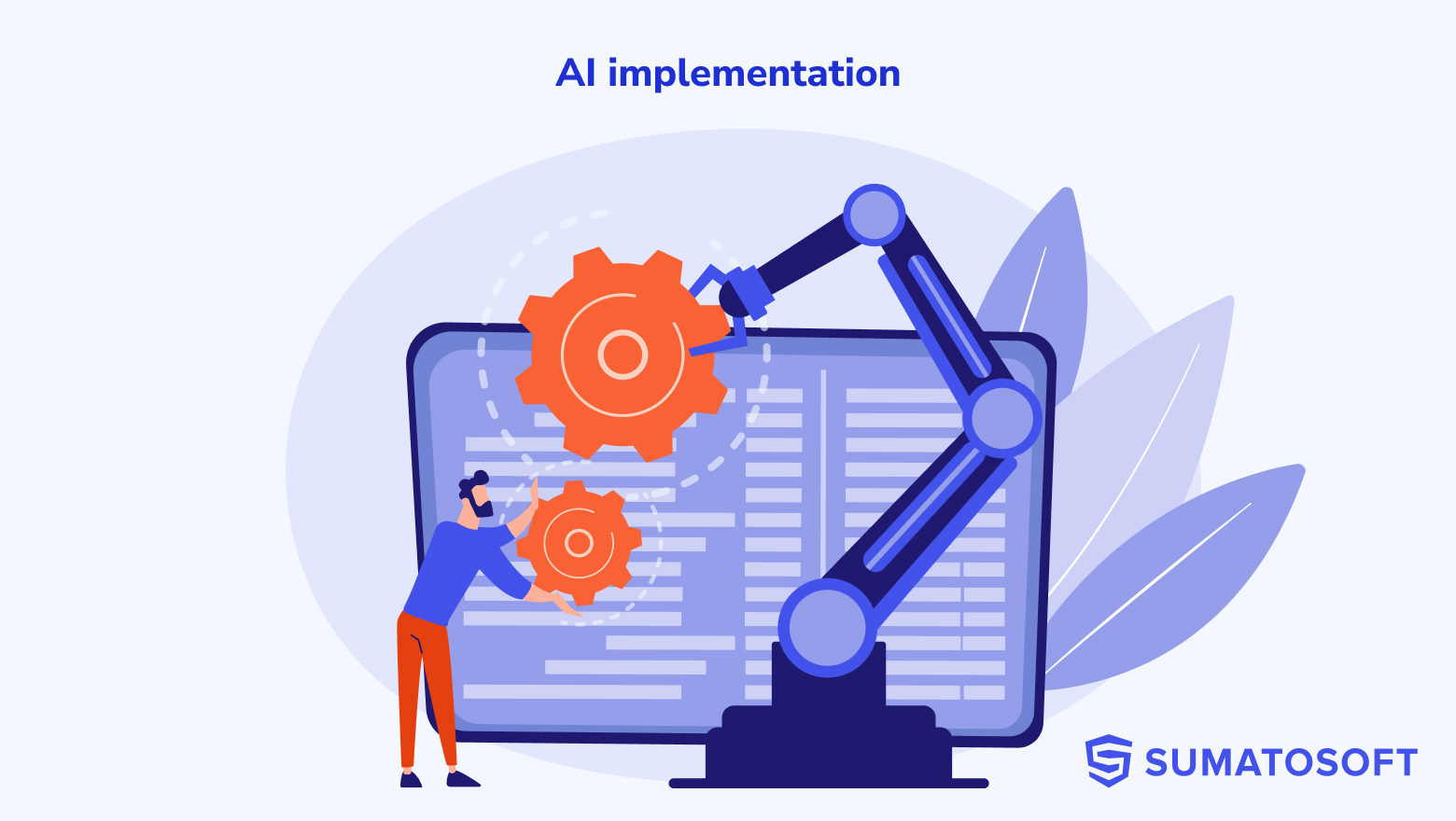Ultimate Guide: Custom CRM System Development
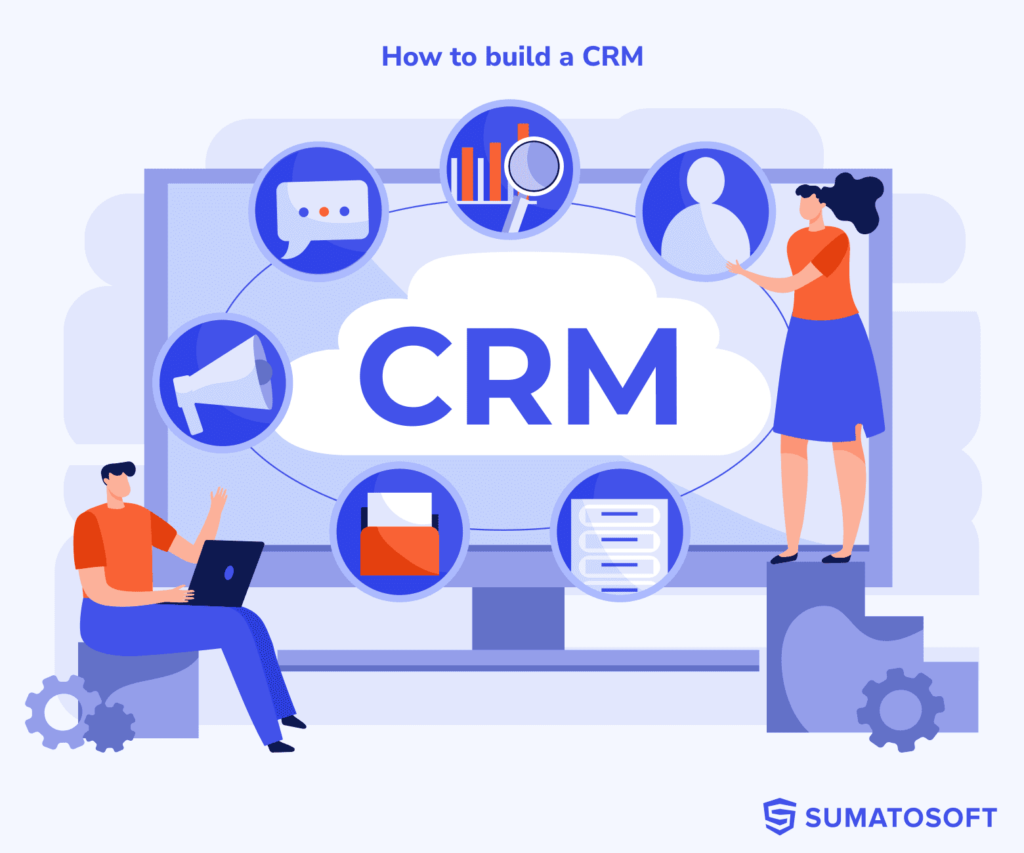
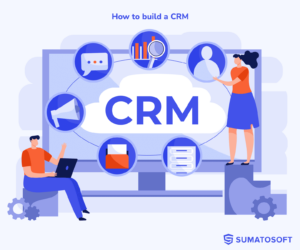
Did you know that companies with fully utilized CRM systems can increase their sales by up to 29%?
That’s not just an estimate—it’s a statistic reported by Salesforce, highlighting the substantial impact a cloud-based CRM system can have on businesses. A well-implemented CRM system can transform medium and large businesses. In the enterprise realm, CRM is not just a tool; it’s a comprehensive strategy that enables organizations to foster customer loyalty, streamline their sales processes, and deliver personalized customer experiences at scale.
As a software developer at SumatoSoft, I develop custom enterprise software solutions tailored to the expansive needs of medium and large businesses. In this article, I want to share insights and knowledge on how to build a custom CRM system, with a particular emphasis on large-scale operations typical of enterprises.
Key Considerations For Implementing CRM in Your Business
Let’s start with a strategic snapshot that will guide enterprises toward getting a CRM to enhance customer relations and operational efficiency. The visual distills the CRM concept into key questions to answer for enterprises: the rationale for adoption, the main users, essential functions, the traits of an effective system, and how to evaluate the effect of implementing a CRM.
Think about this picture before moving on.
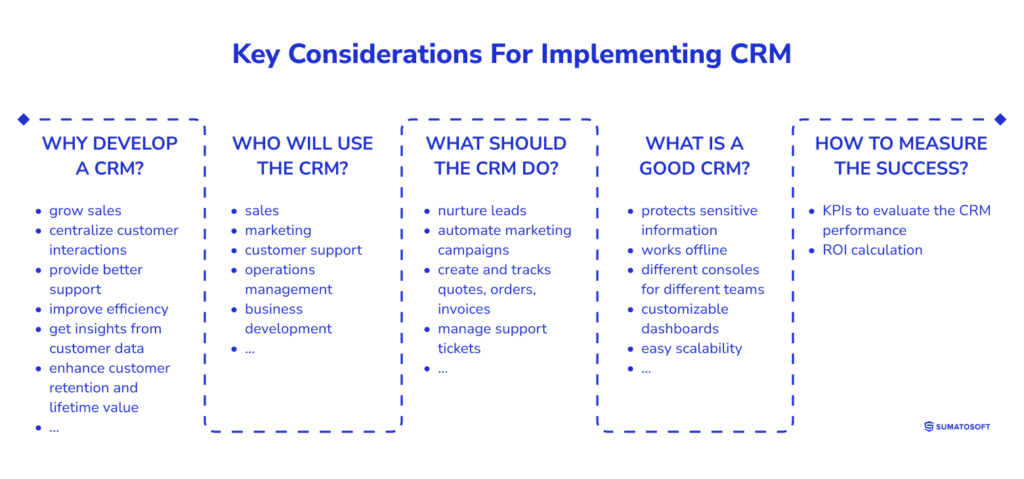
CRM Use Cases for Business Efficiency and Growth
For medium and large businesses, a CRM system must cover a comprehensive range of use cases to manage customer relationships and support business processes effectively. Every use case corresponds to one or another advantage of software solutions for enterprises.
Here’s a list of critical use cases that an enterprise-level CRM should typically cover:
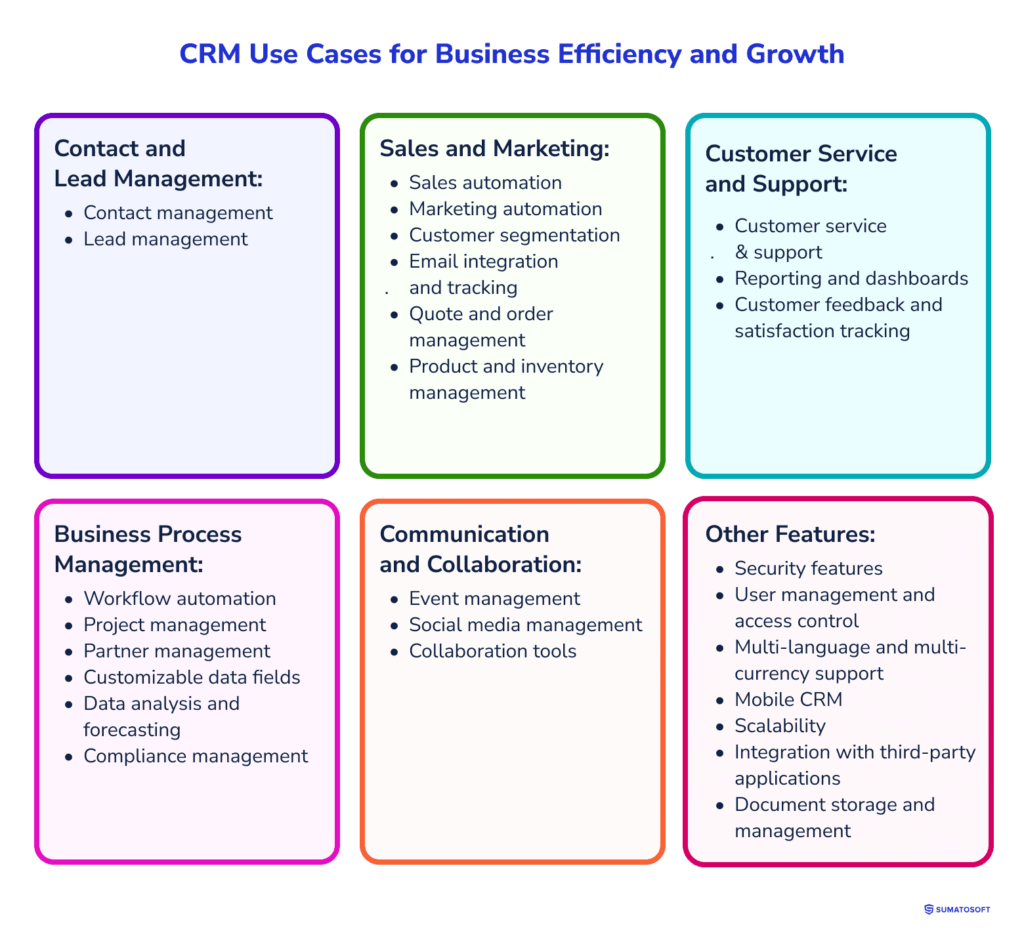
Contact and Lead Management:
- Contact management. Centralizing all contact information and interaction history for customers and leads.
- Lead management. Tracking and nurturing potential Clients through the sales pipeline.
Sales and Marketing:
- Sales automation. Streamlining and automating key sales processes.
- Marketing automation. Automating marketing campaigns, tracking engagement, and analyzing campaign performance.
- Customer segmentation. Grouping customers into segments for targeted marketing and sales initiatives.
- Email integration and tracking. Integrating with email systems for communication tracking and campaign management.
- Quote and order management. Creating and tracking quotes, orders, and invoices directly within the CRM.
- Product and inventory management. Managing product catalogs and inventory levels.
Customer Service and Support:
- Customer service & support. Managing support tickets, tracking service requests, and facilitating customer service operations.
- Reporting and dashboards. Generating real-time reports and customizable dashboards for insights into sales, marketing, and customer service performance.
- Customer feedback and satisfaction tracking. Capturing and analyzing customer feedback to improve products and services.
Business Process Management:
- Workflow automation. Custom workflows to automate business processes and administrative tasks.
- Project management. Tracking projects, associated tasks, and deadlines.
- Partner management. Managing partner relationships, tracking referrals, and joint sales processes.
- Customizable data fields. Customizing the CRM to capture industry-specific data.
- Data analysis and forecasting. Analyzing data to predict trends and forecast sales.
- Compliance management. Ensuring data handling complies with regulations such as GDPR.
Communication and Collaboration:
- Event management. Managing events, tracking participation, and follow-up with attendees.
- Social media management. Integrating social media interactions and data into the CRM.
- Collaboration tools. Facilitating internal communication and collaboration within the CRM.
Other Features:
- Security features. Providing robust security measures to protect sensitive customer data.
- User management and access control. Managing user roles and permissions to ensure data security.
- Multi-language and multi-currency support. Supporting global business operations with multiple languages and currencies.
- Mobile CRM. Ensuring full CRM functionality is available on mobile devices for a mobile workforce.
- Scalability. The ability to scale up as the enterprise grows in size and complexity.
- Integration with third-party applications. Seamlessly integrating with other enterprise tools and platforms.
- Document storage and management. Storing and managing relevant customer documents and contracts.
CRM and ERP: Understanding the Distinctions and Synergies
One thing worth mentioning:
There is some overlap between the use cases of Customer Relationship Management (CRM) systems and Enterprise Resource Planning (ERP) systems, primarily because both are designed to streamline business processes. However, they focus on different areas of a business.
Here are the areas where CRM and ERP systems may overlap:
| Area of Overlap | Overlap description |
| Customer Data Management | Both systems typically include tools to store and manage customer information. While CRMs focus on sales prospects and customer interactions, ERPs might use customer data for invoicing, shipping, and service management. |
| Sales Order Processing | CRM systems often include features to track the sales pipeline and order status, while ERP systems are used to manage the back-end of the order processing including inventory management, order fulfillment, and accounting. |
| Marketing Automation | Some ERP systems have marketing modules that overlap with CRM functionalities like campaign management, email marketing, and lead tracking. |
| Reporting and Analytics | Both CRMs and ERPs provide reporting capabilities. CRMs tend to focus on sales forecasts, customer engagement, and pipeline reports, while ERPs generate operational reports, financials, and efficiency analytics. |
| Workflow Automation | Both systems may include workflow automation to streamline internal processes, reduce manual entry, and ensure the smooth operation of business practices. |
| Project Management | Some ERP and CRM systems have project management functionalities that allow for the planning, execution, and tracking of projects. |
| Service Management | For businesses that provide services, both CRM and ERP systems can track service delivery, manage service orders, and support activities. |
Despite these overlaps, the core focus of each system is distinct:
- CRMs are primarily focused on front-office activities, such as sales, marketing, and customer service. They help businesses manage relationships with potential and current customers, track customer interactions, and drive sales growth.
- ERPs, on the other hand, are integrated systems that manage core business processes, often in real-time and mediated by software and technology. They cover a broader range of business functions, including supply chain management, accounting, procurement, human resources, and more, focusing on back-office activities and operational efficiencies.
Enterprises often integrate their CRM and ERP systems to create a seamless flow of information across the business. This integration can reduce data silos, improve customer experiences, and provide comprehensive insights into business performance.
CRM Implementation: Overcoming Challenges
Implementing a CRM system within a company with large-scale operations is a complex task, fraught with unique challenges but also rich with opportunities for transformative solutions. The journey to implementing a sophisticated CRM platform is not just a technical upgrade – it’s a strategic overhaul that impacts every facet of an organization.
However, the research from Academia Edu, a US repository of academic articles, emphasizes that many companies find it challenging to integrate CRM technology into their core marketing processes.
And here is why:
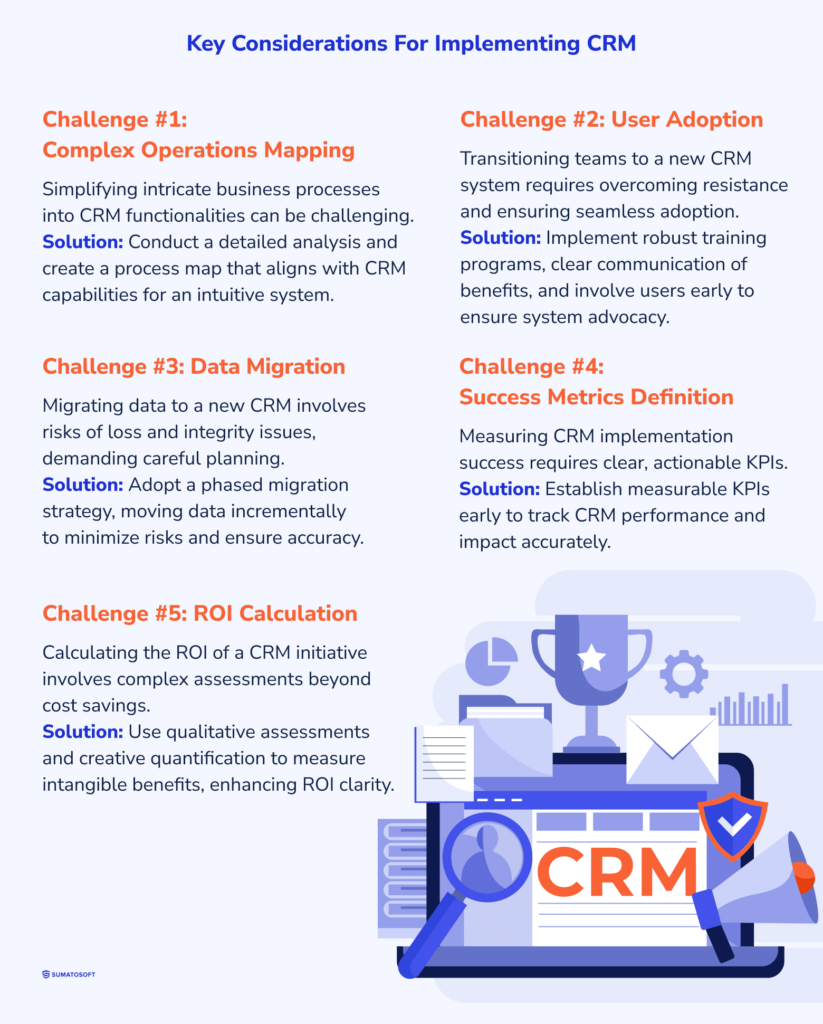
Challenge #1: Mapping Complex Operations to CRM Functionalities
Large businesses often operate through intricate, multi-layered processes that is challenging to encapsulate within a CRM system. For instance, a customer’s order journey may start from an online inquiry, move through personalized sales consultations, involve custom billing procedures, and require post-sales support. Each of these steps may involve different teams with their own ways of tracking and managing information.
In a CRM system, capturing this journey accurately is crucial. A CRM must track the customer’s initial inquiry, log interactions during the sales consultation (like emails, calls, or meetings), seamlessly integrate with the billing system to reflect custom quotes, and finally, connect with a service ticketing system for post-sales support.
The challenge is to ensure that the CRM can handle and connect all these disparate pieces of information, providing a single, coherent view of the customer’s journey through the enterprise’s complex operational landscape. This holistic view is vital for delivering seamless customer experiences and efficient internal coordination.
Solution:
The solution lies in a meticulous analysis of business processes, identifying core activities that drive value, and tailoring CRM functionalities to enhance these processes. A detailed process map that aligns with the CRM’s capabilities ensures that the system reflects the actual workings of the business, providing a platform that is both intuitive and effective.
Challenge #2: Change Management and User Adoption
The success of a CRM system hinges not just on its technical capabilities but also on its acceptance by the people who will use it daily.
Consider a sales team that’s used to managing Client information via spreadsheets and direct emails. Introducing a CRM system will require them to adapt to a new way of working, which includes entering data into the CRM, tracking interactions through the system, and relying on it for their sales processes.
Change management comes into play here to ensure this transition is smooth and the CRM is embraced. This involves careful planning to address resistance, providing thorough training to demonstrate the CRM’s benefits, and ensuring there is ample support available as the team learns the new system. The goal is to make the CRM an integral part of the daily workflow for all users, ensuring that it becomes a tool they rely on, rather than an additional burden they have to manage.
Solution:
To facilitate user adoption, I advocate for a robust training program, a clear communication plan outlining the benefits of the new system, and an inclusive approach that considers feedback from all user levels. By involving users early and often in the CRM journey, their adoption and eventual advocacy for the system are secured.
Challenge#3: Data Migration: Transitioning with Ease
Migrating data to a new CRM system is akin to moving a business’s nerve center. For example, an enterprise might have years of customer data spread across various databases, each containing valuable sales records, service cases, and customer contact information.
During migration, all the data must be carefully extracted, cleansed, and restructured to fit the new CRM’s architecture without losing any of the detail or historical context that gives the information its value.
Data integrity means that once moved, the data still accurately reflects the customer’s history and interactions with the company. Continuity is crucial; the business must be able to operate seamlessly before, during, and after the migration, with no loss of operational capability.
Solution:
The best practice here is a phased migration strategy, where data is moved and tested incrementally. The strategy involves breaking down the data migration process into manageable stages, rather than attempting to transfer all data at once.
Start by migrating data from high-priority departments such as sales or customer service first. Each phase allows for specific datasets to be moved, integrated, and rigorously tested within the new CRM environment to ensure accuracy and functionality.
This approach not only minimizes risks but also allows for troubleshooting issues without disrupting the entire business operation.
Challenge #4: Defining Success Metrics
Success in CRM implementation is not about the deployment; it’s about the outcomes. Enterprises must define clear KPIs, such as customer retention rates, lead conversion rates, or sales cycle lengths, to measure the CRM’s performance. These metrics should be established early in the planning phase and monitored continuously to evaluate the system’s impact.
Solution:
Define the KPIs from the start. It will not only provide you the measurable metrics of success after the CRM implementation but give clear outcomes you want to get.
Challenge #5: Calculating ROI
Finally, understanding the return on investment (ROI) is pivotal for justifying the CRM initiative. Unfortunately, the calculation itself is a very daunting and complex process, and the results often don’t show the real benefits of implementing a CRM.
ROI should not be assessed on cost savings alone but also on the value added through increased sales opportunities, improved customer satisfaction, and enhanced decision-making capabilities. A comprehensive ROI calculation will account for both direct and indirect benefits of the CRM system over time.
Solution:
Calculating intangible benefits requires a blend of qualitative assessment and creative quantification strategies. But it’s essential to get measurable results. Here is what you can do:
- Utilize customer satisfaction surveys before and after the implementation. It can reveal enhancements in customer contentment, with subsequent increases in loyalty and retention rates potentially boosting revenue when assessed against the lifetime value of customers.
- Analyze employee productivity through key performance indicators, such as customer issues resolved or sales closure rates. It can highlight productivity gains, translating time saved into cost savings or additional revenue.
- Calculate potential cost avoidance, like reduced customer churn or lower staffing needs. It provides a tangible value to these otherwise intangible outcomes.
Developing a CRM: From Integrated Modules to Custom Development
Enterprises have 3 paths to consider. And I’ll go from the easiest way to the most complex and costly. Go from top to bottom, moving to the next scenarios if finding previous ones inappropriate.
Scenario 1: Utilizing an ERP’s Built-In CRM Module
This scenario involves activating and using the CRM module already present within your ERP system. It’s the most straightforward approach, leveraging the ERP’s inherent capabilities to manage customer relationships without the need for external integration. It could be a SaaS ERP or on-premise – doesn’t matter.
Here are well-known ERP systems that offer a CRM module:
- SAP S/4HANA;
- Oracle NetSuite;
- Microsoft Dynamics 365;
- Sage 300;
- Infor CloudSuite CRM;
- Epicor ERP;
- Acumatica Cloud ERP;
- SYSPRO ERP.
If you have one of them, lucky you are. Contact your account manager and ask about the opportunities and terms of connecting a CRM module to your current system.
When referring to:
- the enterprise is already leveraging an ERP system;
- the need for a CRM solution has become urgent;
- you’re content with the performance and capabilities of your current ERP system.
What you will get:
- the opportunities of the CRM module of the ERP vendor;
- unified, consistent and accurate data;
- quick and guided setup process;
- the same touch point of communication regarding any issues – your account manager;
- reduced complexity in IT infrastructure and management thanks to a single software vendor.
Limitations:
- feature set confined to the vendor’s CRM capabilities;
- potential lack of niche features, such as advanced AI-driven insights or industry-specific functionalities, limiting tailored CRM strategies.
- dependence on a single vendor for both ERP and CRM functionalities, which could pose risks if the vendor’s solutions do not keep pace with industry advancements.
Cost:
- Development and customization: minimal to none
- Integration: negligible
- Subscription fees: depend on the ERP vendor’s pricing model, but lower than acquiring a separate CRM system.
- Training and support: some costs that may be partially covered under the existing ERP support package.
- Data migration: low to none
- Infrastructure: no additional infrastructure costs
Scenario 2: Integrating an Off-the-Shelf CRM with Existing ERP
This scenario entails choosing a standalone CRM solution from the market and integrating it with the current ERP system. It allows enterprises to select a general CRM or an industry-focused CRM with specific features tailored to their customer relationship management needs. Here is a brief list of the most well-known general and focused CRMs with industries they serve:
- HubSpot – general, manufacturing, marketing
- Microsoft Dynamics 365 – general, finance, retail, manufacturing
- NetSuite – general, eCommerce, wholesale distribution
- Salesforce – general, healthcare, finance, retail, manufacturing
- Zendesk – customer service across various industries
- Pipedrive – general, manufacturing, sales-focused businesses
- Freshsales – general, with a strong focus on sales automation and contact management
- Infor CRM – general, manufacturing, distribution
- Zoho CRM – general, real estate, retail, finance
- Oracle’s Siebel CRM – healthcare, finance, automotive, consumer goods
- SAP Customer Experience (formerly SAP C/4HANA) – retail, manufacturing, professional services
- Propertybase – real estate, with a focus on real estate agents and brokers
- Amadeus Hospitality CRM – hospitality, specifically designed for hotels and the travel industry
When referring to:
- regardless of whether the enterprise currently utilizes an ERP system;
- the enterprise requires some industry or niche-specific set of functionalities;
- the enterprise has to comply with some specific regulations, such as patient data management in healthcare or laws and regulations in finance.
- you have time and budget to find the optimal CRM solution and integrate it with inner systems.
What you will get:
- a CRM with a diverse set of features;
- the ability to choose a CRM perfectly aligned with your business requirements;
- round-the-clock support and maintenance from external providers;
- pricing that adjusts to your needs, varying by user count or other vendor-specific criteria;
- scalability that accommodates user growth and the addition of new functionalities;
- immediate access to the newest technologies like AI and Voice Assitance, deployable with just a few discussions with an account manager.
Limitations:
- excessive features can complicate operations without adding clear value.
- the system may lack the flexibility needed for some business processes.
- difficulties can arise when linking with older or bespoke ERPs.
- initial attractive prices can quickly escalate with the addition of necessary customizations, integrations, and scaling opportunities.
- moving customer data can be challenging, with risks to data integrity.
Cost:
- Development and customization: serious customization costs since the vendor isn’t familiar with your business.
- Integration: negligible in case the vendor provides integration with your ERP system, and significant if the integration is absent.
- Subscription fees: depend on the ERP vendor’s pricing model, but are higher than the first scenario. These fees often escalate quickly after implementing the CRM (see limitations).
- Training and support: low because vendors often have comprehensive learning resources and may offer webinars and training, sometimes at an additional cost or as part of their services.
- Data migration: from low to high depends on the integration options. Without integration, the migration could be complex and incur costs for larger datasets.
- Infrastructure: if the CRM is cloud-based, additional infrastructure costs might be minimal, but on-premise solutions could require new hardware or upgrades.
Scenario 3: Developing a Custom CRM
This scenario involves the development of a CRM system following the general process of custom software development: requirements gathering, design, development, testing, integrating, deployment, and training. It represents a solution designed from the ground up to fit unique business processes, offering unparalleled customization and flexibility.
When referring to:
- regardless of whether the enterprise currently utilizes an ERP system;
- the enterprise seeks functionalities that are not available in off-the-shelf CRM solutions.
- the enterprise has to comply with some specific regulations, such as patient data management in healthcare or laws and regulations in finance.
- the enterprise is ready for long-term custom development in about one year.
- the business requires a CRM that can evolve with its changing needs and scale accordingly.
What you will get:
- a CRM built to match exact business requirements, workflows and processes.
- the potential for perfect integration with the existing ERP and other systems.
- high levels of customization and scalability that are agreed upon even before the development starts.
- direct control over the development and future enhancements of the CRM system.
Limitations:
- custom CRM development requires high upfront costs, encompassing everything from design to deployment.
- longer development and deployment timelines.
- finding a trustful software provider is a challenging task.
Cost:
- Development and customization: significant, as the CRM is built to spec, involving detailed planning, design, and coding.
- Integration: potentially high, depending on the complexity of integrating the custom CRM with the existing ERP system and other business applications.
- Subscription fees: none.
- Training and support: some cost because custom training programs will need to be developed, and internal or external support structures established.
- Data migration: high based on the complexity and diversity of existing data.
- Infrastructure: additional infrastructure costs may be necessary, especially for on-premise deployments, to support the custom CRM system.
SumatoSoft’s Way of Developing a Custom CRM
We developed a custom CRM for the Toyota car dealer, leveraging Ruby on Rails and Scrum methodology for quick development and integration. We focused on creating a CRM module that includes virtual desktops tailored for different employee roles, streamlining customer support and task management.
The CRM features an interactive UI and integrates with existing systems, automating sales and service processes, reducing costs, and improving customer retention. After the implementation of the CRM module many company’s processes of selling and servicing cars were automated, the company has reduced operational costs, hastened sales cycles and improved customer retention rates.
Some More Facts About SumatoSoft:
- We deliver custom enterprise software development services and build solutions like ERP, CRM, document management systems, and human resource management systems.
- We build software for multiple industries: various industries like eCommerce software, Elearning development, Financial software development, healthcare software development, Real Estate, Logistics software, Travel, and more.
- 60 specialists on board, 12 years on the market.
- 70% of our team is senior-level developers.
- We focus on long-term cooperation. 70% of our clients come back to us with another project.
- Thanks to our strong commitment to deadlines and their needs, our Client satisfaction rate is 98%.
- We are a member of The Council for Inclusive Capitalism;
- We are recognized as top software developers by leading analyst agencies like Techreviewer, Clutch, and Goodfirms.
- We only release the software if it meets the specified percentage of acceptance criteria. The percentage is agreed upon with you in the quality assurance strategy.
Get in touch with us for a free consultation. Let’s build a new product together.
SumatoSoft is great in every regard including costs, professionalism, transparency, and willingness to guide. I think they were great advisors early on when we weren’t ready with a fully fleshed idea that could go to market. They know the business and startup scene as well globally.
They did a great job hitting cost estimates and are a bargain for quality. They also helped our business concept greatly. We are confident in our plan and future in the hands of SumatoSoft.
Words From the Author
In conclusion, my role as a software developer at SumatoSoft has allowed me to witness the transformative potential of a well-crafted CRM system in the enterprise world.
CRM systems allow to elevate sales, optimize operations, enhance customer experience, unlock new business opportunities, nurture loyal customers, boost brand reputation, and offer a multitude of other benefits.
Embracing CRM integration can be a challenging journey, one that I wholeheartedly recommend for every enterprise to embark upon.
If you need a CRM, feel free to get in touch with the company I’m working on!
Let’s start
If you have any questions, email us info@sumatosoft.com



